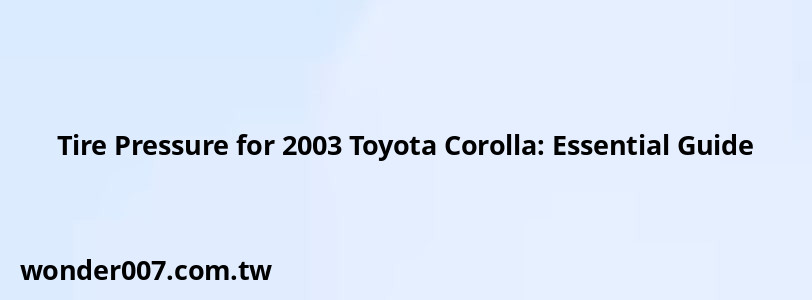Tire Pressure for 2003 Toyota Corolla: Essential Guide

The recommended tire pressure for a 2003 Toyota Corolla is 30 psi (pounds per square inch) for both front and rear tires. This pressure is specified by Toyota for optimal performance, safety, and fuel efficiency.
Importance of Correct Tire Pressure
Maintaining the correct tire pressure is crucial for several reasons:
- Improved fuel efficiency
- Better handling and stability
- Even tire wear
- Enhanced safety on the road
Underinflated tires can lead to increased fuel consumption, poor handling, and premature wear. Overinflated tires can result in a harsh ride and reduced traction.
Checking Tire Pressure
To ensure your 2003 Toyota Corolla's tires are properly inflated:
- Check tire pressure when the tires are cold (vehicle hasn't been driven for at least 3 hours)
- Use a reliable tire pressure gauge
- Remove the valve cap and press the gauge firmly onto the valve stem
- Compare the reading to the recommended 30 psi
- Adjust the pressure as needed
It's advisable to check your tire pressure at least once a month and before long trips.
Adjusting Tire Pressure
If your tire pressure is below 30 psi:
- Use an air compressor to add air until you reach the recommended pressure
- Recheck the pressure after filling to ensure accuracy
If your tire pressure is above 30 psi:
- Press the center of the valve stem to release air
- Recheck the pressure and repeat if necessary
Tire Pressure in Different Conditions
While 30 psi is the standard recommendation, you may need to adjust tire pressure in certain situations:
- When carrying heavy loads, increase pressure by 2-3 psi
- In hot weather, check pressure more frequently as heat can increase tire pressure
- For high-speed driving or long trips, consider increasing pressure by 2-3 psi
Always refer to your vehicle's owner's manual for specific recommendations.
Tire Maintenance Tips
To ensure optimal performance and longevity of your 2003 Toyota Corolla's tires:
- Rotate tires every 5,000 to 8,000 miles
- Check for uneven wear patterns
- Inspect tires regularly for damage or foreign objects
- Replace tires when tread depth reaches 2/32 of an inch
Proper tire maintenance, including maintaining correct tire pressure, can significantly improve your vehicle's performance, safety, and fuel efficiency.
FAQs About Tire Pressure for 2003 Toyota Corolla
- Can I use the maximum pressure listed on the tire sidewall?
No, always use the manufacturer's recommended pressure of 30 psi, not the maximum pressure on the tire sidewall. - How often should I check my tire pressure?
Check your tire pressure at least once a month and before long trips. - Is it normal for tire pressure to fluctuate?
Yes, tire pressure can change with temperature variations. Check and adjust when tires are cold for accuracy.
Related Posts
-
2018 Hyundai Elantra GT Rear Wiper Blade: Essential Replacement Guide
29-01-2025 • 192 views -
Tire Pressure for Hyundai Sonata: Essential Guide for 2017 Models
30-01-2025 • 242 views -
Air Filter for 2002 Honda Accord: Essential Buying Guide
30-01-2025 • 185 views -
Best Spark Plugs for Jeep Patriot: A Comprehensive Guide
28-01-2025 • 171 views -
How To Adjust Camber On Chevy Truck: A Step-by-Step Guide
26-01-2025 • 166 views
Latest Posts
-
Rear Brake Caliper Piston Won't Compress
01-02-2025 • 363 views -
How To Turn Off Paddle Shifters Mercedes
01-02-2025 • 391 views -
Are O2 Sensors Covered Under Warranty
01-02-2025 • 381 views -
2015 Chevy Traverse AC Recharge Port Location
01-02-2025 • 422 views -
Power Steering Fluid Leak On Passenger Side
01-02-2025 • 466 views
Popular Posts
-
EPC Light: Understanding Causes and Solutions
26-01-2025 • 1073 views -
Hino Warning Lights: Understanding Dashboard Alerts
26-01-2025 • 814 views -
Power Steering and ABS Light On: Causes and Solutions
27-01-2025 • 652 views -
Toyota Hiace: Fuel Efficiency Insights for 2025
26-01-2025 • 669 views -
V12 Engine Costs: What You Need to Know
26-01-2025 • 695 views
